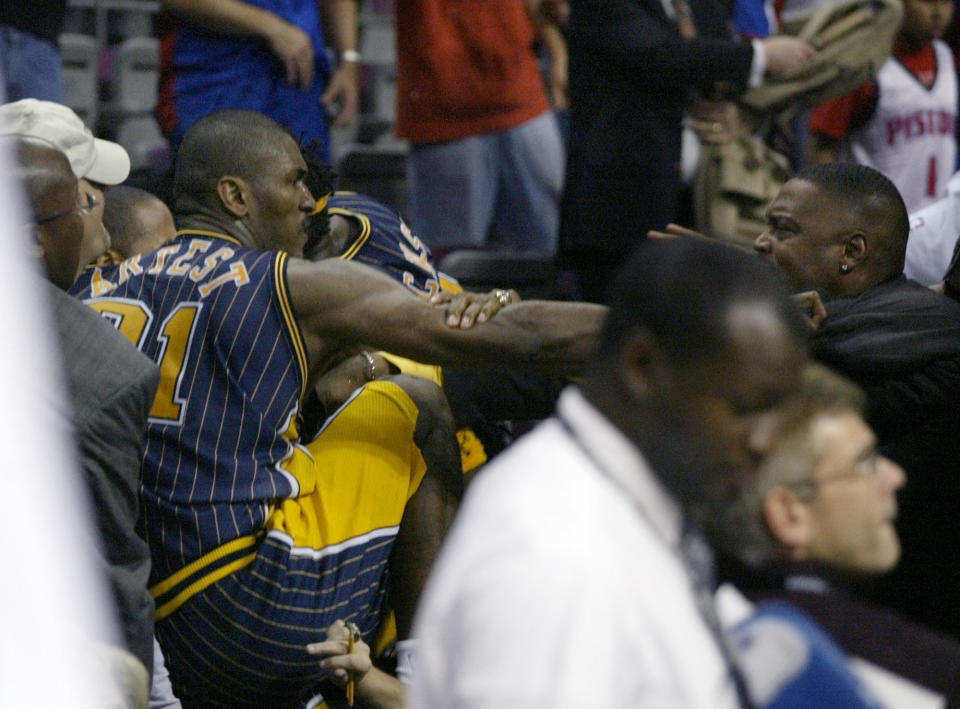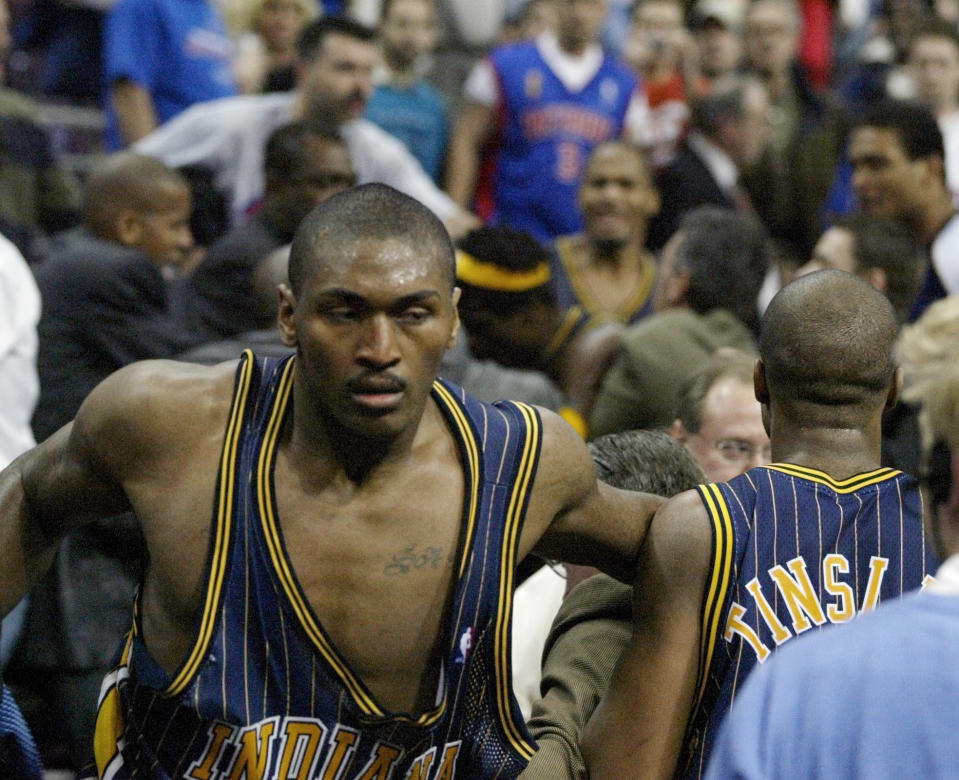15 years later: Inside ‘The Malice at the Palace’
Ben Wallace was seething, being pulled back to the Detroit Pistons’ bench by teammates in the waning seconds of a fiercely physical game against the Indiana Pacers on Nov. 19, 2004.
The Pacers’ Ron Artest succeeded in getting under Wallace’s skin, giving him a hard foul on a drive that started a chain of events that hadn’t been seen in modern sports history. Wallace delivered a two-handed shove to Artest’s face, and all 10 players on the floor were barking and having to be separated before something catastrophic happened.
In that moment, Ben Wallace was ready for a fight.
But he wasn’t ready for a brawl, and he damn sure wasn’t ready for Malice.
Wallace’s Pistons were the rough and rugged defending champions after a tough climb to the title in June 2004. The Pacers were their biggest foes in the East, a carbon copy of sorts, and came into that matchup exactly 15 years ago ready to send a warning that their playoff rematch would not have the same result as last season.
Wallace was the face of the Pistons; Artest a volatile but talented figure with the Pacers who seemingly danced with danger at every turn.
15 years ago today, the Malice at the Palace happened.
One of the wildest brawls you’ll ever see. 🥊 pic.twitter.com/mbvzCe1Vx7— Complex Sports (@ComplexSports) November 19, 2019
“It was a good game, they had it under control,” Wallace told Yahoo Sports in a recent interview about the 97-82 Pacers win. “It was a walkaway win. Every time we played them it was physical. Low scoring, just the way we liked it.”
Wallace didn’t realize the anniversary of “The Malice at the Palace” was here, saying he gets reminders every now and again, laughing at how much has changed in the NBA and the environment that surrounds it.
No social media, no frame-by-frame coverage, although the brawl that spilled into the stands at The Palace of Auburn Hills was one of the first events of the time to be analyzed second-by-second.
Heck, the constant movement of players nowadays eliminates the possibility of true rivalries, and the Pistons and Pacers were as close to a blood feud as things could get in those days.
Although both teams were extremely physical, a line had never been crossed.
Until that day.
So when Wallace saw Artest suddenly get up after lying on his back on the scorer’s table, he thought Artest was crazy enough to make his way through the media and press row for a piece of him.
“I got ready [to fight],” Wallace told Yahoo Sports. “And then I saw him veer into the stands and I was like, ‘Oh, this isn’t good.’”
One could make the argument that had Artest fought the man who wanted to fight him, the epic level of ugly could’ve been avoided.
But Artest didn’t, and he darted into the first row behind the scorer’s table.
ESPN announcer Mike Breen thought the same initially, proclaiming Artest was trying to get to the Pistons’ bench, unaware a cup containing a beverage was tossed Artest’s way by a fan named John Green, setting off the longest two minutes anyone can remember.

Two minutes.
That’s how long the landscape-altering event lasted, even though it felt like a lifetime. Most of the sellout crowd in the Pistons’ home arena had already filed out, but there were still plenty hanging around, waiting for a final buzzer that never came.
Wallace called it “surreal.”
Bill Walton, Breen’s broadcast partner that night, called it “a disgrace.”
Fans in the stands jumped on Artest when he physically retaliated against the man he thought tossed the beverage at him, and new teammate Stephen Jackson aggressively followed suit. Pacer players David Harrison and Fred Jones tried to go in as peacemakers, but Jones was hit from behind by Wallace’s brother, David, who had been near the scorer’s table when Artest tried to calm himself before the incident began.
“I didn’t know [my brother] was directly involved until the video,” said Wallace before facetiously asking, “Was it really him? It was blurry, I couldn’t tell. It doesn’t surprise me. My brother been whooping ass my whole life.”
Pistons players who climbed over the scorer’s table to get to the stands were trying to calm things down.
Ben Wallace and Pistons teammate Rasheed Wallace made it there, along with ushers and other arena personnel — but they were severely outnumbered.
“I was trying to get up there, but somebody was holding me on the floor,” Wallace said. “It could’ve been Jerry [Hendon, Pistons team security] and Abs [Michael Abdenour, Pistons trainer], but I saw Ron in the stands, and I saw him throwing punches. I was like, this is real crazy. Just seeing him in the stands and everything.”
Even when things started to relatively slow down, fans made their way to the sacred part of the arena — the playing floor. Artest was again confronted by Pistons-jersey-wearing fans and delivered a punch. Pacers center Jermaine O’Neal wasn’t far behind with a sliding haymaker that could’ve done serious damage had all his weight been applied.
“It happened so fast,” Ben Wallace said.
The details that have become etched in our brains were a blur in those moments: the Auburn Hills fans throwing objects and liquids onto the Pacers players as they tried to exit and get to the locker room, and a then-mysterious figure only known as “Worldwide Wes” (aka William Wesley) pulling Artest away before a third melee began.
Ben Wallace’s adrenaline was settling down. The game was called with 45.9 seconds remaining, and when the players got to their locker rooms, Wallace said reality “immediately” started to set in.
“Everybody was in their seats. It was quiet,” Wallace said. “LB [Pistons coach Larry Brown] addressed the team and you could see how emotional he was.”
Brown, a basketball purist if there ever were one, was in tears.
“At that point, you could see it was something serious. The suspensions, fines. That wasn’t supposed to happen. We realized then that league was gonna take a big hit,” Wallace said.

The players were shown a replay in the locker room, getting a look from all angles. Wallace had played in Europe before latching on with the then-Washington Bullets in 1996, so he’d seen player-fan interactions cross past the boiling point.
But never in the NBA.
“After I had a chance to watch the replays and all the angles, it was crazy,” Wallace said. “It was a surreal moment, having an out-of-body experience but you couldn’t see all the chaos and everything that was going on.
“This is basketball. We handle those problems within those lines and keep it on the court. We govern ourselves but once it goes into the stands … law enforcement, arbitration, you know it’s different. I knew it was something serious.
“We all crossed the line. The fans crossed the line by coming into the floor. It was fortunate nobody was seriously injured. Then all the court dates and penalties came.”
Then-commissioner David Stern came with a heavy hand, knowing the viability and health of his league were at risk. Artest was suspended for the rest of the season — the longest non-drug-related suspension in NBA history at 73 games — while Jackson had to sit down for 30 games. O’Neal wound up missing 15 games, and Wallace took the heaviest punishment on the Pistons’ side with six games.
Artest, Jackson and O’Neal had to make trips to the Detroit area for court dates, resulting in probation and community service, while Green, the fan who threw the cup, was found guilty of assault and faced a permanent ban from the NBA.
The repercussions were felt far beyond the court.
There wasn’t a party that came away unscathed.
The city of Detroit took another black eye, even though Auburn Hills is nearly 40 miles from downtown.
Arena security became more stiff, and alcohol sales were halted following the third quarter. The player-fan relationship was examined, especially in the context of race: black players, white fans.
The resulting language was coded, and the ever-aware Stern wanted to assuage the public with gestures and changes that felt almost malicious in the moment, issuing a dress code for players upon entering the arena and calling for “business casual” attire.
Back then, players were representative of the culture of the day, eschewing the buttoned-up appearance of the previous generation and trading custom suits for custom jerseys and baggy jeans, among other fashion choices.
On the floor, the rules were changed so the physical slugfests could lead to a better brand of basketball and a more pleasing show to casual fans that could perhaps curtail on-court altercations.
Wallace wasn’t pleased with the dress code, and his style of play was most affected because he made his living on the defensive end — a four-time Defensive Player of the Year. But he understood the game needed to evolve, saying Stern used the moment as an opportunity “to save the game.”
“Our fans, NBA fans, have always been great. One or two have always taken it too far,” Wallace said. “But I’m glad we still have that connection, we can slap hands with them, give them our jerseys and wristbands. Some good came out of it.”

Wallace didn’t talk to Artest directly until Wallace signed with the Chicago Bulls as a free agent in 2006, when Artest was a member of the Sacramento Kings. Civil rights activist Jesse Jackson and others arranged a pregame meeting with the two players.
“They wanted two kings to shake hands and put the past behind him,” Wallace said. “I told them I was a Ron Artest fan, it was just one of those nights I wasn’t."
Wallace acknowledges his reaction to Artest’s hard foul was a catalyst, but still felt the need to defend himself a year later when he was in Las Vegas at a blackjack table with a childhood friend.
“The pit boss just started randomly talking about the NBA,” Wallace said. “And he brought up the brawl. He said, ‘Ben Wallace started that mess.’”
Unbeknownst to the pit boss, Wallace was at the table as he continued to talk.
“‘That little push, he just wanted to fight,’” Wallace recalled the pit boss saying. “I asked him, ‘If somebody walked off the street and smacked you, what would you do?’ He said, ‘I’d try to beat him to death.’”
It was at this moment Wallace knew he was still incognito, even as a 6-foot-7 rock of a human being. The pit boss never put the obvious together, and Wallace wasn’t going to break character.
Wallace never removed his hat and kept engaging — out of pure humor.
“It was funny because he was going on and on,” Wallace said. “He said I could’ve took it. The size I was. He basically said [I] had an attitude problem and I just wanted to fight.”
Wallace chuckled and kept his identity hidden, never revealing who he was and never taking anything back.
“You get judged by that moment,” Wallace said. “We [were] able to regather, but I lost time on the court. Things happen. No regrets. Just a lot of lessons.”
More from Yahoo Sports:

